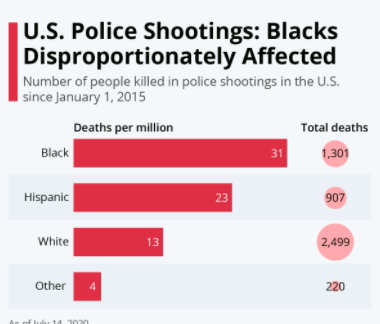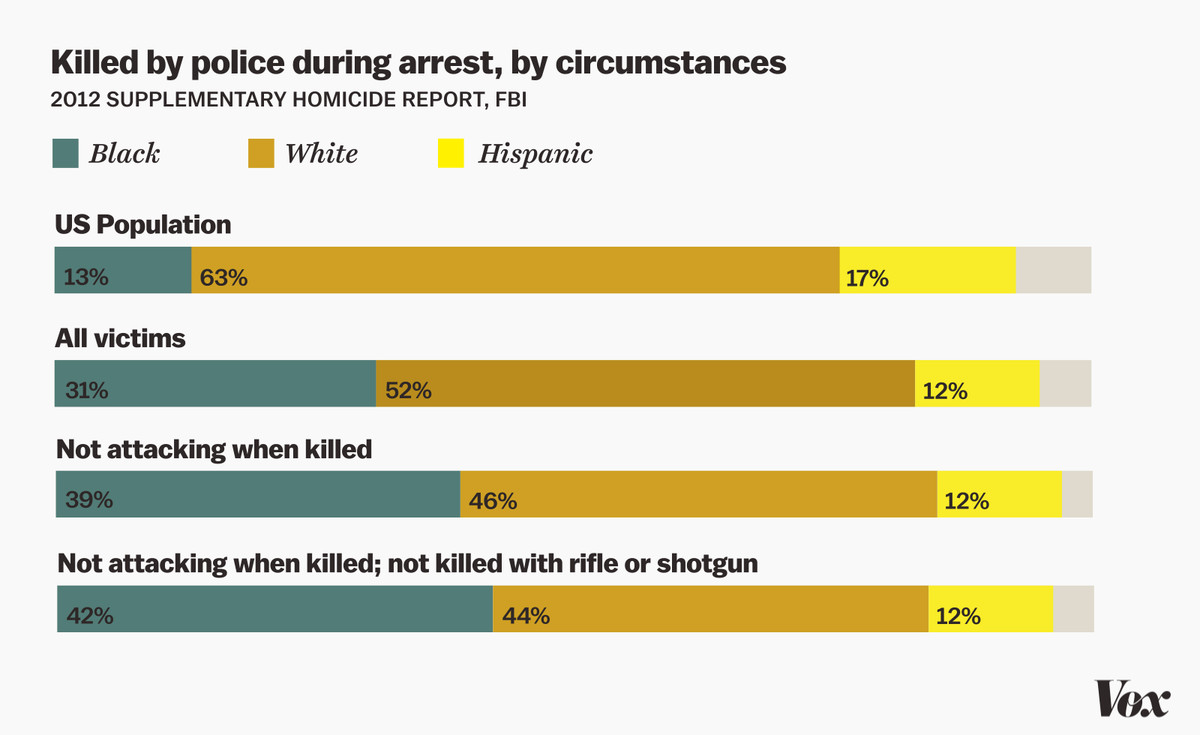Many scholars nowadays believe that races are cultural interventions that are made to reflect given attitudes and norms that are characterized in various global populations. In the United States (US), race refers to individuals who have some physical traits that can be seen, such as skin color, hair texture, and eye formation. The other term, racism, refers to the marginalization of people based on their skin color or physical orientation based on the ethnic profiles that have existed for a long while. Racism has been a major social issue that has caused harm to the victim. Due to racism, African Americans have been segregated in many openings such as employment, judicial matters, and resources allocation. Police brutality against people of color in the US has been rampant for a long time and therefore, there is need to combat the social problem so that the marginalized groups feel safe in the country.
Evidence of the Social Problem
African Americans have been affected by brutal force by the police, as shown in Figure 1 below, in matters regarding law implementation. When a person is caught violating the law, the chances of a black person being interdicted than the whites are high (Gray & Parker, 2020). In most cases, black people have been accused of drug and human trafficking by the police when they are innocent. The police violence has caused death for many young people in the US. It is a fact that about 1 in 1000 black men can be expected to be killed by police at one point in their lives (Arango & Dewan, 2021). There is a risk that when is between 20-35 years, they have a high chance of coming through the brutal implementation of law and order by the police. These traits have been evident for a long while because of the stereotyped ideology that whites are superior to blacks.

Since the civil war in the US started, black people have been misused in many areas whereby the whites have taken advantage of the majority aspect in the US. Black people worked as slaves in agricultural fields where their masters oppressed them inhumanly. The trend has continued today in the 21st-century as one can find that racism is evident in the US and even other parts of the world (Gray & Parker, 2020). The killing of George Floyd by the Minneapolis police agents sparked a heated revolution against the oppression of African Americans by the disciplined forces. The world became critical of the video clip that surfaced online on mainstream and social media channels (Peeples, 2021). In the video, a policeman named Derek Chauvin was seen sitting on George’s neck, where the victim begged the police when he could not breathe simultaneously.
Police brutality affects African Americans in terms of psychological wellbeing. The fear that a black person can be arrested and charged against an issue they have not committed makes black people lack the personal initiatives that may be developmental in life. For example, one may fear opening an enterprise due to the uncertainties that at one time, the property can be confiscated on unreasonable grounds. There is an estimation that more than 300 black people are killed by police every year whereby 25% are unarmed (Gray & Parker, 2020). Police brutality has been termed a threat to public health through activists’ groups that lobby in favor of the end of the social problem. As Figure 2 shows, there is the disproportional killing of black people by the police.

The disproportionate rate of police-centric killings of black people is a key reality that makes people bitter hence, adverse emotional implications. Black people are 2.5 more likely to lose their lives from police brutality which shows that the racism factor has been gone deeper the expected levels. Citing Sandoiu (2020), “Racially unequal exposure to the risk of state violence has profound consequences for public health, democracy, and racial stratification.” Therefore, the implications show that treating people based on their race can be a problem in the society that needs to be combatted with efficacy that shall develop a culture without racism at all. Living in areas where there is a notable presence of whites and racial differences in police work is associated with an increased risk of poor health, such as high blood pressure, obesity, and diabetes (Sandoiu, 2020). Thus, attention is needed to prevent police brutality as it affects marginalized groups, particularly African Americans.
Police brutality is systemic racism that has been ignored in the US. Recently, many groups started demonstrations against police brutality. Many people feel that racism by the police is unhealthy, and it creates class and status that are against the favor of these marginalized groups (Peeples, 2021). There is a need to stop police brutality as, going forward, all human beings need to have the same capacity in all life perspectives. Time has come when Americans should view all races as equal (Sandoiu, 2020). When black people are killed, some families are left in grief whereby children are left partial or full orphans. If police continue to segregate people based on racial orientation, many cases of extrajudicial killings will be reported in the US.
Racism is against the call for respect of human dignity. If African Americans are not given equal handling in criminal justice system, the future will be characterized by inhumane actions from police to the Black people. The fear of being abused racially may make people to doubt their potential to develop important plans that are of benefit to the US and entire world. The United States is a country which plays a role model to many growing nations and hence, racial disparity issues should be combatted. It requires the collaborative efforts between the members of all government organs as well as the humanitarian organizations. Racism should be lowered not only in the US but also all the parts of the world.
Call to Action
Firstly, it is essential to track the problem by checking the data that presents police killings of black people in the US. Having the statistics will establish the grounds under which the problem shall be solved. In this case, having a police database concerning the issue is helpful in building the measure toward ending the issue. When that is done, the racial disparity when it comes to black and police brutality shall end.
Secondly, the US police culture must be changed to better the execution of law and order in society. That is possible through training to reduce racial biases among the members of the police force, which will encourage de-escalation of the same problem. Under this section, the police shall be required to use policies that will limit their decisions about killing when they arrest black people. For example, the policy must require the police to de-escalate the matter before using force, use guidelines that define the correct course of action in crime points, and exhausting of all the options before resolving to deadly force. Lastly, there is a need to have oversight boards that are effective in monitoring the police actions.
References
Arango, T., & Dewan, S. (2021). More than half of police killings are mislabeled, a new study says. Nytimes.com. Web.
Gray, A., & Parker, K. (2020). Race and police killings: Examining the links between racial threat and police shootings of Black Americans. Journal of Ethnicity in Criminal Justice, 18(4), 315-340. Web.
Peeples, L. (2021). What the data say about police brutality and racial bias — and which reforms might work. Nature.com. Web.
Sandoiu, A. (2020). Police violence: Physical and mental health impacts on Black Americans. Medicalnewstoday.com. Web.